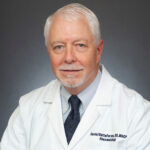PHILADELPHIA—Members of the ACR’s Workforce Solutions Committee presented a chilling picture of the approaching shortage of rheumatologists and discussed their efforts and ideas they hope will avert a gaping void in patient care.
The session was held at ACR Convergence 2022, where the looming workforce shortage was a topic of discussion across many sessions and posters.
The ideas being promoted by the committee, said chair Daniel F. Battafarano, DO, MACP, MACR, adjoint professor of medicine, University of Texas Health San Antonio, are “based on knowledge and data. That’s what’s driven us, not just pie-in-the-sky ideas about workforce solutions.”
Looming Shortage
Dr. Battafarano displayed two maps of the U.S. with boxes showing, by region, the number of adult rheumatologists per 100,000 people and, on the other map, the number of pediatric rheumatologists per 100,000 people, based on the ACR’s 2015 Workforce Study. Next to each of those boxes was another box, with the projected number of adult rheumatologists in 2025 and the projected number of pediatric rheumatologists in 2030.1,2
In the Northwest—a region that includes Washington, Oregon, Idaho, Montana and Wyoming—there were 1.65 rheumatologists per 100,000 people, projected to be 0.5 by 2025.
“That’s a problem,” Dr. Battafarano said. “If you look at every single region in the United States, every single region is decrementing significantly.”
In the same region, there were 0.67 pediatric rheumatologists per 100,000 and a projection of 0.13 pediatric rheumatologists per 100,000 by 2030.
“Pediatrics has been in a crisis since 2015, so if you look at the numbers there, they’ve been very, very small, and they’re getting worse,” he said.
In a study by the Association of American Medical Colleges in 2020, researchers estimated that there will be a shortage of between 54,000 and 139,000 physicians in the country as of 2033, and Dr. Battafarano pointed out that the data suggest the shortage will more likely skew toward the higher end of that range.3 COVID-19 has only made matters worse.
“We lost colleagues to part-time employment, we saw early retirements, and that happened across the United States,” he noted. Early estimates, he said, suggest a 10% reduction in the physician workforce just due to the pandemic, stacked on top of the shortages the field had already been experiencing.
A map showing the distribution of rheumatologists across the country shows barren areas all across the Northwest, upper Midwest, portions of the Southwest and elsewhere.



